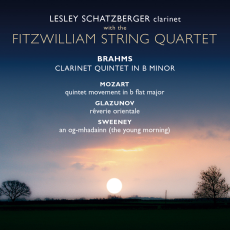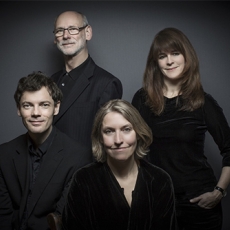Brahms - Lesley Schatzberger and the Fitzwilliams - Audiophile Audition
Clarinet virtuoso Lesley Schatzberger specializes in historic performance, obviously a strong element in the authenticity movement. Her desire to play the Clarinet Quintet of Brahms (1890) using a reproduction of the Ottensteiner instrument employed by its inspirator, Richard Muehlfeld of the Meiningen Orchestra, led to her commissioning such a clarinet. The result is an instrument of delicacy of tone and light action, given the fingering adjustments Schatzberger had to make. The Fitzwilliam Quartet, too, has tried to capture the spirit of the Brahms style, its use of portato bowing and portamento in the execution of two melodic notes.
Schatzberger, a pupil of Alan Hacker, is just as conscious of recorded performance-practice, having auditioned the famed interpretations of the Clarinet Quintet by Reginald Kell and Frederick Thurston. Clearly, Schatzberger covets the passion and rhetorical commitment in the older style, here provided in brilliant surround sound by Julia Thomas at the National Center for Early Music, York (15-20 May 2005). Another romantic impulse in the Quintet is the application of an anagram of Clara Schumann's name, in a descending scale sequence, that unites the piece much as Robert Schumann had deftly written love letters to Clara Wieck. Rather than appeal to autumnal sentiments, the whole enterprise surges with raw emotional power and romantic yearning, a vibrant capacity for life. The blazing attacks from first violin Lucy Russell and cellist Andrew Skidmore in the variations of the last movement attest to a unanimity of mind that this music pulses with the ferment of eternal youth.
Mozart's incomplete Allegro movement in B-flat for basset clarinet (c. 1791) takes advantage of the instrument‚s capacity to descend to written C. The three-quarter meter of the piece (with analogies in other symphonies and chamber works) and the existence of several kinds of models has allowed editor David Druce to complete the movement, granted that Mozart's capacity for invention can never be second-guessed. The first violin enjoys a deliciously extensive concertante part, while Schatzberger plies a B-flat clarinet based on a model by Ackerman with basset extension. The luscious motifs from the string quartet blend perfectly with the clarinet in surround sound, whether in arioso or rocket passagework.
Glazounov's sultry, exotic Oriental Dream (1886) derives from an Adagio for two clarinets. Any name-that-tune aficianado would quickly deem the piece to be by Borodin. Over languorous wavering harmonies, the clarinet weaves a seductive melody that might be a dirge for the late Yvonne de Carlo. Instant glamor, should this piece get discovered by the populist-classical radio stations, like KDFC.
Alan Hacker himself commissioned the An Og-Mhadainn (The Young Morning) for basset-clarinet of Glasgow-born composer William Sweeney (b. 1950). Ostinato figures in the strings lead to a series of variations on a melody which provides its own accompaniment. The piece is optimistic, a reflection of energizing mornings, Sweeney's answer to The Lark Ascending. A bit repetitious, minimalist in its own terms, the piece (especially in the latter half) allows the basset-clarinet's resonance a robust demonstration of its varying timbres and registers.


